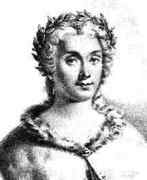Person: Bassi, Laura Maria Catarina

Laura Bassi was an Italian physicist and one of the earliest women to gain a position in an Italian university.
Mathematical Profile (Excerpt):
- As Tacconi realised Bassi's remarkable intellectual abilities he introduced her to advanced science topics, including Isaac Newton's Optics which she could read in the Latin.
- Several of the scholars who were members of the Academy of Science of Bologna were invited to Bassi's home by Tacconi, himself a member of the Academy, and she entered into disputations with them on philosophical topics.
- Lambertini became Bassi's patron and, to show off his protégé, set up a debate between her and four professors from Bologna on 17 April 1732.
- The debate was held in the grand Palazzo Pubblico in Bologna and Bassi defended forty-nine philosophical theses.
- The uniqueness of this event is explained by the fact that the candidate was not a young man, as we would expect, but a young woman, 20 year old Laura Bassi.
- Because of her sex, Laura had to perform in a very public manner in order to obtain recognition of her abilities and knowledge.
- At this time Bassi began to distance herself from Tacconi's advice.
- He had wanted her to concentrate on theses involving ethics, but Bassi, supported by Lambertini.
- He was not, however, considered to be as good a scientist as Bassi.
- Despite becoming Laura Veratti at this stage, she is usually known by the name Bassi and we will continue to use 'Bassi' through the rest of this article.
- The marriage was considered wrong by many in Bologna who felt, in the same spirit as fellows in Colleges at the University of Cambridge could not marry and continue to hold their fellowships, Bassi should not be allowed to marry and continue to hold a lecturing position.
- Actually Bassi's lecturing position was not all that it might seem, for it only allowed her to lecture on special occasions when the lecture was open to the public when anyone, including women, could attend.
- Marriage actually improved this difficult situation, for Bassi was now allowed to lecture in her home.
- This meant that Bassi had far less access to her patron, but nevertheless she was still able to communicate with him via Scarselli.
- Bassi asked Scarselli to try to persuade the pope to appoint her as the twenty-fifth Benedettini.
- This was a difficult decision since some of the twenty-four who had already been appointed were opposed to Bassi joining the select group while others supported her.
- In the end Benedict XIV went for a compromise solution by appointing Bassi as the twenty-fifth Benedettini but not giving her the same voting rights as the others.
- The high esteem in which Bassi was held during her lifetime is very evident from the writings by those who knew her.
- Bassi's main contributions were made in physics although she wrote papers on a number of other scientific subjects including two mathematics papers.
- As we mentioned above, Bassi was a staunch supporter of Newton and her lectures were designed to introduce her students to Newtonian physics.
- Of 28 papers by Bassi which are held in the Bologna Academy of Sciences in Bologna, thirteen are on physics, eleven are on hydraulics, two are on mathematics, one is on mechanics, one is on technology, and one is on chemistry.
- This work by Bassi signals the beginning of a trend in dissertations concerning the classical mechanics given at the Academy.
- This simplification was provided by Bassi when she reduced the equation to one unknown by the analytic method.
- Rather strangely, the main subject on which Bassi undertook experimental work was electricity yet she never wrote a paper on the topic.
- Some visitors wanted to view experiments done by Laura or Giuseppe; at other times they performed experiments with the couple on interesting problems of the day.
- Laura debated with men on several of the ideas that were of prime interest in her time, especially those regarding theories of electricity, gases, and water.
- Bassi became the first woman appointed to a chair of physics at any university in the world.
- Bassi's death was sudden and described at the time as "an attack in the chest" which may indicate a heart attack but other causes are also possible.
- After much discussion, it was decided that the image of Bassi should be placed above the door to the Nautical Room in the Institute, where many of Marsili's beloved model ships were housed.
- During her lifetime Bassi had constantly reminded her colleagues that she was not simply a figurehead, but a practicing experimental philosopher who wished to teach as well as perform research.
- Smiling benignly down upon her former colleagues in effigy, and buried wearing her silver crown of laurels, Bassi re-entered the realm of mythology from which she had emerged.
- While there can be no doubt that the city itself accentuated Bassi's fame in order to promote its own glory, the little we know about her physical researches and her Newtonian commitment is enough to make it clear that she deserves a place in the history of science.
Born 31 October 1711, Bologna, Papal States (now Italy). Died 20 February 1778, Bologna, Papal States (now Italy).
View full biography at MacTutor
Tags relevant for this person:
Origin Italy, Women
Thank you to the contributors under CC BY-SA 4.0! 

- Github:
-

- non-Github:
- @J-J-O'Connor
- @E-F-Robertson
References
Adapted from other CC BY-SA 4.0 Sources:
- O’Connor, John J; Robertson, Edmund F: MacTutor History of Mathematics Archive
